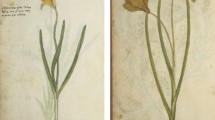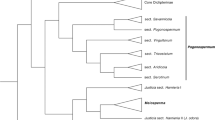Abstract
A character analysis reveals a clearly intermediate position of the tetraploidV. persica (2n = 28) between the two diploid speciesV. polita andV. ceratocarpa (both 2n = 14) which are morphologically rather different and have been placed by several authors in different sections of the genus.V. ceratocarpa is native to subhumid deciduous forests of the Caucasus and of the Elburz mountains (N. Iran);V. polita has its centre of variation in the Elburz range where it grows in therophyte habitats. Three other closely related species,V. bungei, V. siaretensis, andV. francispetae, are endemic to the Elburz range which is the main centre of diversity and variability of theV. agrestis group. This comprises all the above mentioned species and also two more European weeds:V. agrestis andV. opaca. Veronica polita, was probably originally native to open places in deciduous mountain forests, before becoming a weed in neolithic times and migrating to Europe; nowadays it has an almost world-wide distribution. The allotetraploidV. persica combines the ecological characters of its parents, the slightly xerophyticV. polita and the more mesophyticV. ceratocarpa, thus being preadapted to become a highly successful weed with a large ecological range. It has spread rapidly almost all over the world since the early 19th century.
Similar content being viewed by others
References
Baker, H. G., 1965: Characteristics and modes of origin of weeds. — InBaker, H. G., Stebbins, G. L., (Eds.): The Genetics of Colonizing Species, pp. 147–172. — New York etc: Acad. Press.
—, 1972: Migration of weeds. — InValentine, D. H., (Ed.): Taxonomy, Phytogeography, and Evolution, pp. 327–347. — London etc.: Acad. Press.
—, 1974: The evolution of weeds. — Ann. Rev. Ecol. Syst.5, 1–24.
Beatus, R., 1934: Der Erbgang der Pentasepalie bei den Zwischenrassen vonV. tournefortii. — Jahrb. Wiss. Bot.79, 256–295.
—, 1936: DieVeronica-GruppeAgrestis der SektionAlsinebe Griseb., ein Beitrag zum Problem der Artbildung, I. Die Zytologie der GruppeAgrestis. — Z. Ind. Abst.-Vererb.71, 353–381.
Bentham, G., 1846:Scrophulariaceae, p. 485. — Inde Candolle, A.: Prodromus Systematis Naturalis Regni Vegetabilis10. — Paris: Masson.
Boissier, E., 1879: Flora Orientalis4, 463. — Genevae & Basileae: H. Georg.
Borisova, A. G., 1955:Veronica. — InŠiškin, B. K., &Bobrov, E. G., (Eds.): Flora SSSR22, 329–500. — Moskva & Leningrad: Izd. Akad. Nauk SSSR.
Clapham, A. R., Tutin, T. G., Warburg, E. F., 1962: Flora of the British Isles. 2nd ed. — Cambridge: Univ. Press.
Clausen, J., Keck, D. D., Hiesey, W. M., 1940–1958: Experimental studies on the nature of species I., II., III., IV. — Carnegie Inst. Wash. Publ.520, 564, 581, 615.
De Langhe, J.-E., Delvosalle, L., Duvigneaud, J., Lambinon, J., vanden Berghen, C., 1983: Nouvelle Flore de la Belgique, du Grand-Duché de Luxembourg, du Nord de la France et des Régions voisines (Ptéridophytes et Spermatophytes). 3. ed. — Meise: Ed. Patrim. Jard. bot. nat. Belgique.
Ehrendorfer, F., 1962: Cytotaxonomische Beiträge zur Genese der mitteleuropäischen Flora und Vegetation. — Ber. Deutsch. Bot. Ges.75, 137–152.
—, 1963: Cytologie, Taxonomie und Evolution bei Samenpflanzen. — Vistas in Botany4, 99–186.
- 1965: Dispersal mechanisms, genetic systems, and colonizing abilities in some flowering plant families. — InBaker, H. G., Stebbins, G. L., (Eds.): The Genetics of Colonizing Species, pp. 331–352.
Ehrendorfer, F., 1980: Polyploidy and distribution. — InLewis, W. H., (Ed.): Polyploidy — Biological Relevance, pp. 45–60. — New York etc.: Plenum Press.
Elenevskij, A. G., 1978: Sistematika i geografija veronik SSSR i priležaščih stran. — Moskva: “Nauka”.
Ellenberg, H., 1974: Zeigerwerte der Gefäßpflanzen Mitteleuropas. — Scripta Geobot.9. — Göttingen: E. Goltze.
—, 1982: Vegetation Mitteleuropas mit den Alpen in ökologischer Sicht. 3. ed. — Stuttgart: E. Ulmer.
Fischer, M. [A.], 1969: Einige Chromosomenzahlen aus den GattungenVeronica, Pseudolysimachion, Paederota, Wulfenia undLagotis (Scrophulariaceae/Veronicinae). — Österr. Bot. Z.116, 430–443.
—, 1973: Notizen zur Systematik, Chromosomenzahl und Verbreitung einigerVeronica-Sippen in Kärnten. — Carinthia II163/83, 379–388.
—, 1975a: On the origin ofVeronica persica Poir. — Abstracts XII. Intern. Bot. Congr. [Leningrade]1, 12. — Leningrad: “Nauka”.
—, 1975b: TheVeronica hederifolia group: taxonomy, ecology, and phylogeny. — InWalters, S. M., (Ed.): European Floristic and Taxonomic Studies. — Bot. Soc. Brit. Isl. Conf. Rep.15, 48–60.
—, 1978:Veronica. — InDavis, P. H., (Ed.): Flora of Turkey and the East Aegean Islands6, 685, 689–753. — Edinburgh: University Press.
- 1981:Veronica. — InRechinger, K. H., (Ed.): Flora Iranica147, 52–165, tab. 43–110, 247, 248, 255.
—, 1985 (“1984”): Zur Chorologie und Systematik derVeronica hederifolia-Gruppe in Jugoslawien. — Akad. Nauka Umjetn. Bosne Herceg. (= ANUBiH), Radovi76, Odj. Prir. Mat. N., (Sarajevo)23, 55–77.
Fritsch, C., 1893: Über das Auftreten derVeronica ceratocarpa C. A. Mey. in Österreich. — Verh. k.-k. Zool. Bot. Ges. Wien43, Sitzungsber. 35–37.
Gottschalk, W., 1976: Die Bedeutung der Polyploidie für die Evolution der Pflanzen. — Fortschritte der Evolutionsforschung7. — Stuttgart: G. Fischer.
Grayer-Barkmeijer, R. J., 1973: A chemosystematic study ofVeronica: Iridoid glucosides. — Biochem. Syst.1, 101–110.
—, 1978: Flavonoids inParahebe andVeronica: a chemosystematic study. — Biochem. Syst. Ecol.6, 131–137.
- 1979: Chemosystematic Investigations inVeronica L. (Scrophulariaceae) and Related Genera. — Proefschr. Rijksuniv. Leiden.
Hagerup, O., 1932: Über Polyploidie in Beziehung zu Klima, Ökologie und Phylogenie. — Hereditas16, 19–40.
Harris, G. R., Lovell, P. H., 1980a: Growth and reproductive strategy inVeronica spp. — Ann. Bot.45, 447–458.
—, 1980b: Adventitious root formation inVeronica spp. — Ann. Bot.45, 459–468.
Hartl, D., 1966–1968:Pseudolysimachion. Veronica. — InHegi, G.: Illustrierte Flora von Mitteleuropa6(1), 146–160 (1960), 161–236 (1968). — 2. Aufl. — München: Hanser (bzw. Berlin: P. Parey).
Hayek, A. v., Hegi, G., 1913: Illustrierte Flora von Mittel-Europa6/1, 53–54. — Wien: A. Pichlers Witwe & Sohn.
Hegi, G., Beger, H., 1928:Senecio vernalis. — InHegi, G., 1928–1929: Illustrierte Flora von Mittel-Europa6/2, 781–787. — Wien: A. Pichlers Witwe & Sohn.
Huber, A., 1927: Beiträge zur Klärung verwandtschaftlicher Beziehungen der GattungVeronica, I.: Die Kernuntersuchung in der GattungVeronica. — Jahrb. Wiss. Bot.66, 359–380.
Janchen, E., 1959:Sympetalae. — InJanchen, E., 1956–1960: Catalogus Florae Austriae, I. (Pteridophyta undAnthophyta). — Wien: Springer-Verlag.
Kadereit, J. W., 1984: The origin ofSenecio vulgaris (Asteraceae). — Pl. Syst. Evol.145, 135–153.
Kemuljarija-Natadze, L. M., 1967:Veronica. — InGrossgejm, A. A.: Flora Kavkaza7, pp. 503–524, karta 560–591. — 2. ed. — Leningrad: “Nauka”.
Korsmo, E., 1930: Unkräuter im Ackerbau der Neuzeit. Biologische und praktische Untersuchungen. — Berlin: J. Springer.
Kühn, F., 1975: [Pflanzenüberreste aus der großmährischen Siedlungsgeschichte in Šlapanice.] — Přehled výzkumů1974, p. 50–52. — Brno.
Landolt, E., Grossmann, F., 1968: Zur vermutlich hybridogenen Entstehung von einigen Wiesenpflanzen des schweizerischen Mittellandes. — Verh. Schweiz. Naturforsch. Ges.1968, 114–117.
Lange, E., 1973: Unkräuter in frühgeschichtlichen Getreidefunden. — Ethnogr.-Archäol. Z.14, 193–221.
Lehmann, E., 1906: Wanderung und Verbreitung vonVeronica tournefortii Gmel. — Abh. Naturwiss. Ges. ISIS (Dresden)2, 93–107.
—, 1908: Geschichte und Geographie derVeronica-GruppeAgrestis. — Bull. Herb. Boiss., 2. sér.,8(4, 229–244, 337–352, 410–425, 644–660.
—, 1909a: Einige Mitteilungen zur Kenntnis der GattungVeronica. — Österr. Bot. Z.59, 249–261, Taf. 5.
—, 1909b: Über Zwischenrassen in derVeronica-GruppeAgrestis. — Z. Ind. Abst.-Vererb.2(3, 145–208, Taf. 1.
—, 1942: Die Einbürgerung vonVeronica filiformis Sm. in Westeuropa und ein Vergleich ihres Verhaltens mit dem vonV. Tournefortii Gm. — Gartenbauwissensch.16, 428–489.
—,Schmitz-Lohner, M., 1954: Entwicklung und Polyploidie in derVeronica-GruppeAgrestis. — Z. Ind. Abst.-Vererb.86, 1–34.
Löve, A., 1956: Cytotaxonomical conspectus of the Icelandic flora. — Acta Horti Gotob.20, 65–291.
Májovský, J., & al., 1974a: Index of chromosome numbers of [the] Slovakian flora (Part 3). — Acta Fac. R. N. Univ. Comen. Bot.22, 1–20.
—, 1974b: Index of chromosome numbers of [the] Slovakian flora, Part 4. — Acta Fac. R. N. Univ. Comen. Bot.23, 1–23.
Manton, I., 1934: The problem ofBiscutella laevigata L. — Z. Ind. Abst.-Vererb.67, 41–57.
—, 1937: The problem ofBiscutella laevigata L., II. The evidence from meiosis. — Ann. Bot. (Oxford), n. s.,1, 339–462.
Meškova, L. Z., 1965: Primenenie kariologičeskih issledovanij k sistematike rodaVeronica L. — Aftoref. Kand. Dis. Kazan'.
Meusel, H., Jäger, E., Rauschert, S., Weinert, E., 1978: Vergleichende Chorologie der zentraleuropäischen Flora2. — Jena: G. Fischer.
Mulligan, G. A., 1959: Chromosome numbers of Canadian weeds, II. — Canad. J. Bot.37, 81–92.
—, 1965: Recent colonization by herbaceous plants in Canada. — InBaker, H. G., Stebbins, G. L., (Eds.): The Genetics of Colonizing Species. — New York etc.: Acad. Press.
Oberdorfer, E., 1983: Pflanzensoziologische Exkursionsflora. — 5. ed. — Stuttgart: E. Ulmer.
Opravil, E., 1978: Synanthrope Pflanzengesellschaften aus der Burgwallzeit (8.–10. Jahrh.) in der Tschechoslowakei. — Ber. Deutsch. Bot. Ges.91, 97–106.
Peev, D., 1982: Different substitution tendencies of leaf flavones in theVeronica hederifolia group (Scrophulariaceae). — Plant Syst. Evol.140, 235–242.
Römpp, H., 1928: Die Verwandtschaftsverhältnisse in der GattungVeronica. — Feddes Repert. Beihefte50.
Rothmaler, W., & al., 1982: Exkursionsflora für die Gebiete der DDR und der BRD. Band 4. Kritischer Band. — 5. ed. — Berlin: Volk & Wissen.
Schroeder, F.-G., 1969: Zur Klassifizierung der Anthropochoren. — Vegetatio/Acta Geobot.16, 225–238.
—, 1974: Zu den Statusangaben bei der Floristischen Kartierung Mitteleuropas. — Gött. Florist. Rundbr.8(3, 71–79.
Speta, F., 1986: Heterokarpidie, Dehiszenz, Heterospermie und basifixe Samen beiCymbalaria Hill. (Scrophulariaceae) und systematische Schlußfolgerungen. — Phyton (Austria)26, 23–57.
Stebbins, G. L., 1950: Variation and Evolution in Plants. — New York: Columbia Press.
—, 1971: Chromosomal Evolution in Higher Plants. — London: E. Arnolds.
Stroh, G., 1942: Die GattungVeronica L., Versuch einer systematischen Kodifizierung der Arten. — Beih. Bot. Centralbl.61 B, 384–451.
Tacik, T., Trzcińska-Tacikowa, H., 1963:Veronica L., Przetacznik. — InPawlowsky, B., (Ed.): Flora Polska10, 280–338. — Warszawa & Kraków: Panstw. Wydawn. Naukowe.
Tischler, G., 1934: Die Bedeutung der Polyploidie für die Verbreitung der Angiospermen, erläutert an den Arten Schleswig-Holsteins, mit Ausblicken auf andere Florengebiete. — Bot. Jahrb.67, 1–36.
Trzcińska-Tacik, H., 1964: RozmieszczenieVeronica agrestis L.,V. opaca Fr. iV. polita Fr. w Polsce i na terenach sasiednich./The distribution ofV. a., V. o., andV. p. in Poland and the adjacent territories. — Fragm. Flor. Geobot.10(1, 61–79.
Walter, H., Straka, H., 1970: Arealkunde. Floristisch-historische Geobotanik. — 2nd ed. — Einführung in die PhytologieIII/2. — Stuttgart: E. Ulmer.
Wulff, H. D., 1937: Chromosomenstudien an der schleswig-holsteinischen Angiospermenflora, I. — Ber. Deutsch. Bot. Ges.55, 262–269.
Author information
Authors and Affiliations
Additional information
Dedicated to Hofrat Univ.-Prof. DrKarl Heinz Rechinger on the occasion of the 80th anniversary of his birthday.
Rights and permissions
About this article
Cite this article
Fischer, M.A. On the origin ofVeronica persica (Scrophulariaceae)—a contribution to the history of a neophytic weed. Pl Syst Evol 155, 105–132 (1987). https://doi.org/10.1007/BF00936294
Received:
Issue Date:
DOI: https://doi.org/10.1007/BF00936294




